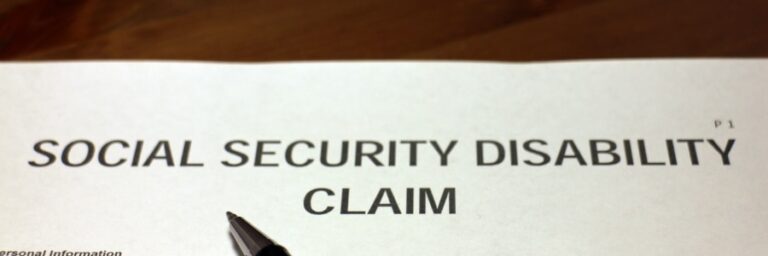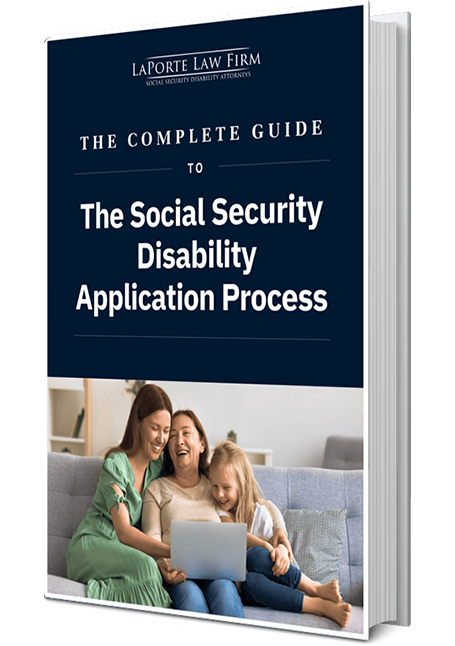
According to the Social Security Administration (SSA), approximately 22% of all initial applications for Social Security Disability Insurance (SSDI) get approved. Unfortunately, this means the majority of applications — a whopping 63% — are denied. But if your SSDI application is rejected, don’t fret: you can appeal up to the federal court level to ensure you get the benefits you deserve.
In this article, we will explain the Social Security disability appeals process, the appropriate grounds for appeal, and the potential outcomes of federal court lawsuits.
What Does Appealing Your Disability Claim Mean?
If you receive a denial of your disability benefits and you have exhausted your administrative remedies — meaning all of your previous appeals have been denied — you may file an appeal in federal court. This means that you bring a civil action against the Social Security Administration in Federal District Court. You may seek a thorough review of your claim and the disability denial by a federal judge, who will evaluate the legal aspects and the decision-making process of the previous denial. The federal suit is a final opportunity for individuals whose disability claim has been repeatedly denied by the SSA.
There are multiple administrative stages in the Social Security disability process. If your initial disability application is denied, you can file the first appeal called the Request for Reconsideration. If your appeal at the Request for Reconsideration stage is denied, you can file a second appeal called the Request for Hearing. During this stage of the case, a hearing is held with an administrative law judge (ALJ) who issues a final decision. If the judge issues an unfavorable decision or a partially favorable decision, you can file the final administrative appeal with the appeals council. If the appeals council rejects your appeal, you will have exhausted your administrative options and may file a lawsuit in federal court.
Filing a suit in federal court requires comprehensive preparation, solid evidence, and often, legal representation. The chances of succeeding in a lawsuit in federal court increase if you follow the proper procedural rules and make the appropriate legal arguments that demonstrate why you were improperly denied disability benefits. You must explain why you are disabled and what harmful legal errors the Social Security Administration made when denying your claim for disability benefits.
Grounds for Appeal
Once your case is appealed and filed in federal court, the consideration is different. During the administrative process, the Social Security Administration uses its regulations to review the available evidence to determine if you are disabled. This is a factual consideration. But during a federal court lawsuit, the Federal District Court will review the SSA’s denial to determine if there were errors of law. This is a legal consideration. In a federal court case, you will have to explain the harmful legal errors that occurred when the SSA denied your claim. To determine if there were any harmful errors in your case, you’ll need to review the judge’s unfavorable decision. Carefully read the decision to determine what mistakes were made.
Here are some of the legal arguments that may be successful in a federal court appeal.
Errors of law
When the Social Security Administration is determining whether you are disabled, they are bound by particular laws and regulations. There may be grounds for appeal if the court or administrative law judge made a legal error in interpreting or applying the law.
For example, the SSA and the ALJ are required to consider medical opinion evidence, including those from your treating physicians. When the SSA considers how persuasive they find this medical opinion evidence, they must consider the supportability and consistency of the medical opinion. If the ALJ fails to evaluate or properly consider opinion evidence from your treating physicians, this may be a harmful legal error that you can discuss in your appeal. Between 2010 and 2020, this legal error was the most common reason the federal court decided in favor of claimants and remanded the case for a rehearing.
Inadequate consideration of evidence
The SSA must consider all probative evidence when determining if you are disabled. If the administrative law judge failed to review or consider key pieces of medical evidence, you may have grounds to appeal in federal court. For example, it would be a significant error to ignore medical opinion evidence from your treating physicians or important tests or surgical reports. In other instances where you were unrepresented at the time of your hearing, the ALJ errs when they do not request and obtain updated medical evidence that is important to your case.
Factual errors
SSA staff members and administrative law judges are human. They make mistakes. And it’s possible that their unfavorable decision on your case includes factual errors. It’s thus important that you review your denial notice for factual errors, which you can and should present in federal court.
Take note, though, that factual errors are only important to an appeal if the Social Security Administration was clearly mistaken about an important finding in the decision. The federal court will review errors in the unfavorable decision to determine if they are “material” or “harmless.” In other words, if the error had not been made, would it have made a difference to the outcome of the case?
For example, if the unfavorable decision gets a date or name wrong, this may not make a difference to your appeal. But if the decision gets your age wrong, and this puts you in a younger age category, this may be an important error that is worthy of appeal. In most cases, a claimant’s age has little effect on the severity of the disability. But age may be an important consideration when the Social Security Administration determines you could perform other work in the national economy. If the SSA determines that you cannot perform your past work, it must then determine if you can perform any other work. They will take into consideration age when determining what other work in the national economy you can perform, because advancing age is a limiting factor in the ability to adjust to other work.
The SSA classifies individuals into different age groups, each with specific names and criteria
- Younger Individuals (age 18–50)
- Closely Approaching Advanced Age (age 50–54)
- Advanced Age (age 55 and older)
- Approaching Retirement Age (age 60–67)
As you enter into older age categories, the Social Security Administration looks at a narrower range of work you may adjust to. If the unfavorable decision states that you are49 but you are actually 50, this may be a serious factual error that could make a difference in your appeal. This error is not “harmless” or “inconsequential” because the rules are significantly different if you are 50 years old rather than 49 years old. Therefore, failing to account for a change in age category is not the same as citing an incorrect date, medication, or doctor’s name.
The Social Security Administration collected data on the top reasons the court remands cases back to the SSA. You can find those reasons here.
The Appeals Process in Federal District Court
Before you file an appeal in federal court, you must first understand how the Social Security disability appeals process at this stage works:
-
Filing an appeal
After you receive a denial from the Appeals Council, you have 60 days to file a suit in Federal District Court. To do this, you must first file a complaint, which is a statement that explains to the court that you are filing a lawsuit against the Social Security Administration for denying your claim for disability benefits. This complaint is filed with the court and is served on the SSA.
Once the SSA is notified of the lawsuit, they will prepare and submit the administrative record to the court. The administrative record contains all of the exhibits, documents, and decisions in your SSA file. It also contains a transcript of the hearing with the administrative law judge.
-
Filing legal briefs
Once the administrative record is submitted, it is time to file the brief arguing your case. This is called your Motion for Summary Judgment, and it explains why you are disabled, what legal errors the Social Security Administration made when they denied your claim, and why those legal errors led to the denial. The brief must also contain a statement of facts, a statement of the procedural history in your case, and an explanation to the court of the legal rules that they must follow when reviewing the case.
After your brief is submitted, the SSA will file a brief that explains why they denied the claim and argue that the decision should be upheld.
After the SSA, you have one final opportunity to make your last legal argument. This is called the reply. In the reply brief, you can argue against the legal arguments the Social Security Administration made in their briefs.
-
Conducting the review
In most lawsuits in federal court, there are no oral arguments before the judge. The Federal District Court judge will make a decision based on the written briefs submitted in the case. The court will examine the entire administrative record, including medical records, work history, and any evidence submitted throughout the SSA appeals process. They will determine if the Social Security Administration followed proper legal procedures and had sufficient evidence for their decision. The court will then issue its final decision.
Timeline for Federal District Court Appeals
The length of the appeals process varies from case to case, but the process generally follows the timeline outlined below:
-
Initial filing of the appeal
After the final decision by the appeals council, you have 60 days to file an appeal in the Federal District Court. The appeal is initiated by filing a complaint that details the basis for your appeal.
-
Response from the Social Security Administration
Once the complaint is filed, the SSA has 60 days to respond to your complaint. When the SSA files a response, they submit the administrative record of your case.
-
Briefing schedule
After the suit is filed in federal court, the court will set a briefing schedule. This briefing schedule explains the deadlines to file the briefs and the reply briefs. Typically, you have 30 days after the filing of the administrative record to file your brief. Once you file the first brief, the SSA has 30 days after you file your motion to respond.
In some cases, the federal court can revise these time frames by local rules. It is important to check your court’s local rules to see if there is an alternative briefing schedule.
-
Oral arguments
In the vast majority of cases, the court will decide the case based on the written briefs. Typically, the briefing schedule will explain that an oral argument in court will not occur. In some cases, the judge may schedule an oral argument. This scheduling is done at the Court’s discretion.
-
Court’s decision
After the briefs are filed, the court will issue a written decision that summarizes the arguments and explains whether or not the court agreed with your legal arguments. The timing to receive this decision can vary widely, as the court is not bound by any deadlines. It can take a few months to a year to receive a decision.
-
Motion for reconsideration or appeal to the appellate court
If the court issues a denial, in order to file an appeal, you can file a Motion to Alter or Amend the Judgment within 28 days, or file a Notice of Appeal within 60 days of receiving the decision.
Potential Outcomes of Your Appeal
There are four possible outcomes at the federal court level:
-
Outcome 1: Your appeal is approved
The court finds in your favor and overturns the initial denial of your disability claim. This is called an allowance. The court also determines that you are disabled and entitled to disability benefits, and it will send your case back down to the Social Security Administration for payment of benefits.
-
Outcome 2: Your claim is remanded
The court may decide to remand your claim. This means sending your case back to the Social Security Administration for further review and consideration, which involves a subsequent hearing. To learn more about a remand hearing, you can review our blog article here.
-
Outcome 3: Your appeal is denied
The court can deny your claim and uphold the SSA’s original unfavorable decision. If you receive a denial, you have the option to appeal to a higher court.
-
Outcome 4: Dismissal
In about 5% of claims, the court will dismiss the lawsuit. In a dismissal, the court will not consider the merits of the lawsuit. A dismissal usually occurs after a procedural error, such as failing to file the lawsuit in a timely manner.
Stipulation: After the complaint is filed but before all of the legal briefs are filed, the Social Security Administration may choose to settle the case. They may conclude that the legal arguments are meritorious and decide that the case should be remanded or reversed for payment of benefits without further court action.
What If Your Case Is Remanded?
If your case is remanded, it is sent back to the Social Security Administration for further consideration. The court will explain what legal errors occurred at the initial hearing and may also instruct the SSA on how to correct the errors.
The case is first sent back to the appeals council, which will process the court’s decision and issue corrective instructions. The corrective instructions tell the administrative law judge how to correct the errors that were made in the initial hearing. The case will then be set for a new hearing, where you will have another opportunity to explain why you are disabled.
While a remand offers another chance for your disability claim to be reviewed, it does not guarantee a different outcome as the judge may still reach the same decision as before. To learn more about how to prepare for a remanded hearing, click here.
What Happens If Your Appeal is Denied?
If the Federal District Court denies your suit, you can still file an appeal to a higher court called the Federal Circuit Court of Appeal. An attorney will evaluate if it is the appropriate decision to file an appeal in the Federal Circuit Court of Appeal.
If your claim is denied yet again, you may also file a new disability application. This new application can be filed while your suit in federal court is pending. You do not need to wait for the outcome from the federal court to file a new application. If you file a new application after a denial, the Social Security Administration will presume that you remain not disabled. You will have to demonstrate that there was a change in circumstances to refute the presumption. A changed circumstance may be a new disability, an increase in the severity of your current impairment, or the existence of an impairment not previously considered. In this new application, the SSA will only consider if you are disabled after the date the judge issued the unfavorable decision.
Tips for Success in Your Federal District Court Appeal
You can ensure a favorable decision on federal court appeal by following these tips:
Understand the appeals process
To file a suit in any federal court, you must have an understanding of the proper procedural rules. The federal court requires that you follow the Federal Rules of Civil Procedure, any local court rules, and the newly issued Supplemental Rules for Social Security Actions effective December 2022. These rules explain how to file the complaint and briefs, how they should be formatted, and the timeline in which to submit them. The federal court process can be rigid; missing deadlines or failing to comply with the rules can result in a dismissal of your suit.
Review the administrative record thoroughly
As mentioned above, the Social Security Administration will submit the administrative record together with their response to your complaint. The record contains all of the documents and evidence submitted in your case. It is critical to carefully review each page of the record to understand the procedural history in your case, the medical evidence that supports your disability, and any errors or omissions that could help your appeal.
Submit a detailed brief
After the record is thoroughly reviewed, it is important to note the legal errors that were made when the SSA denied your claim. A brief will be more successful if it explains the legal errors, not the factual dispute, and cites to the administrative record throughout the brief so that the reviewing court has a reference for each argument.. An appeal must also explain how each error was harmful. This means that the error was so significant that it affected the outcome of the claim.
The brief is the only opportunity to convince the court to rule in your favor. It should be thorough, persuasive, and adhere to all formatting rules.
Stay patient and persistent
The appeals process can be lengthy, often taking up to a year or more. Staying patient and persistent is key to potentially winning your appeal.
Most Importantly, get legal Representation
Hiring an attorney experienced in federal court appeals increases your chances of success. An experienced attorney understands the intricacies of the law, the appropriate standards of review, and the rules of civil procedure, and can explain them to you so you know what to expect at each stage of the process.
FAQs
An appeal to the federal district court requires a lot of patience. At a minimum, it takes several months to receive a decision, but it can take closer to several months if the Social Security Administration agrees to a stipulation. In some cases, it may take a year or more. The appeal will take closer to a year if SSA does not want to settle the case and the court takes its time to consider all briefs and evidence before issuing a decision.
Yes, you can represent yourself without an attorney. This proceeding is called pro se. To move forward pro se, you will have to gain a familiarity with the court’s rules of civil procedure and the Social Security regulations and rules. Because of the complicated nature of federal curt proceedings, most claimants are represented by attorneys.
When a lawsuit is filed in federal court, the court requires that you pay a filing fee. Currently, the filing fee is $402. If you are indigent and cannot afford the filing fee, you can file a waiver called the right to proceed in forma pauperis.















